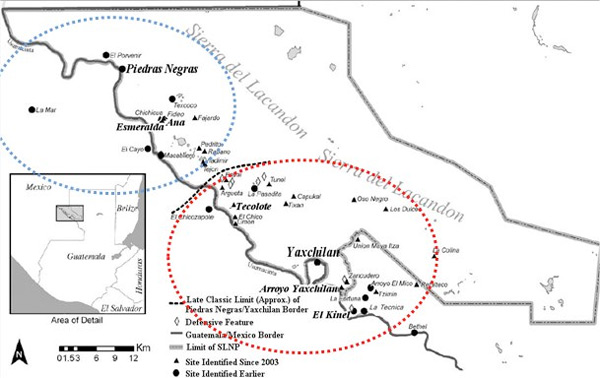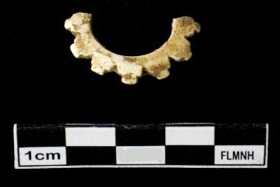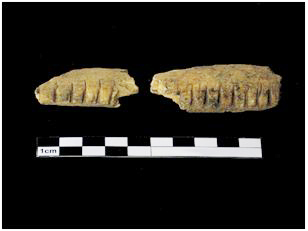The Political Role of Animals in the Sierra del Lacandón, Guatemala
Project Zooarchaeologists: Ashley Sharpe and Kitty Emery
 Animals were used for much more than just food in the past: in many Maya communities, the control of certain animal species played an important role maintaining social networks and hierarchal distinctions.The Sierra del Lacandón Regional Archaeology Project (SLRAP) is currently surveying, mapping, and excavating the territory on the Mexico-Guatemala border once occupied by two large Maya polities, Piedras Negras and Yaxchilan, so as to understand the history of this remote but fascinating region. The two polities rose to political prominence by the Late Classic period (550-850 A.D.), when the capital centers constructed numerous monumental temples, plazas, and stelae, while simultaneously engaging in a series of violent battles over territorial disputes. Although the capital sites of Piedras Negras and Yaxchilan have been investigated previously by archaeologists, many of the smaller subordinate communities have been overlooked until recently. SLRAP’s current goals include mapping the distribution and sizes of these smaller communities in order to determine how the site polities were arranged, how sites may have changed allegiance over time during border disputes, and how these peripheral sites interacted, both politically and economically, with the capitals.
Animals were used for much more than just food in the past: in many Maya communities, the control of certain animal species played an important role maintaining social networks and hierarchal distinctions.The Sierra del Lacandón Regional Archaeology Project (SLRAP) is currently surveying, mapping, and excavating the territory on the Mexico-Guatemala border once occupied by two large Maya polities, Piedras Negras and Yaxchilan, so as to understand the history of this remote but fascinating region. The two polities rose to political prominence by the Late Classic period (550-850 A.D.), when the capital centers constructed numerous monumental temples, plazas, and stelae, while simultaneously engaging in a series of violent battles over territorial disputes. Although the capital sites of Piedras Negras and Yaxchilan have been investigated previously by archaeologists, many of the smaller subordinate communities have been overlooked until recently. SLRAP’s current goals include mapping the distribution and sizes of these smaller communities in order to determine how the site polities were arranged, how sites may have changed allegiance over time during border disputes, and how these peripheral sites interacted, both politically and economically, with the capitals.

The study of how animals were selectively acquired, distributed, and used based on zooarchaeological material provides a unique avenue to investigate sociopolitical relations. There are many questions left unsolved, including:
- Did the two polities acquire and make use of different species or varieties of species? If so, were there environmental or culturally-motivated factors involved?
- Is there any evidence for trade among the communities? Between the communities and outlying regions?
- Did elites and commoners use the same species, or did the elites distinguish themselves using different species, diversities of species, or particular parts of animals?
- Do we see evidence of craft specialization? What does this tell us about how the communities were organized?
- Do we find similarities among the ritual uses of animals? What does this tell us about ritual practices and beliefs?
- Did the use of animal species change through time? What does this tell us about the dynamics of sociopolitics?

To answer this wide array of questions, we’ve implemented a number of diverse strategies to compare the zooarchaeological assemblages from each site through time. These methods include statistical estimates of diversity and equitability, comparisons of skeletal portion distribution among different contexts, and habitat fidelity analysis (Emery and Thornton 2008) to determine the environmental zones from which animals may have been acquired.Although we have only conducted a preliminary analysis (Sharpe and Emery 2015, Sharpe 2011), several intriguing patterns have emerged thus far. There is evidence marine species were transported in bulk to the two capitals, but rarely distributed to the smaller communities. The diversity of animals used or consumed by Maya elites was far less than that used by members of the middle class, although consisted of considerably more exotic and symbolically important species, such as jaguar and tapir. Elites also appear to have been distinguishing their diets from those of the lower classes by consuming proportionately more prime cuts of meat from the fore- and hindlimbs of deer. As we continue to investigate these trends exhibited in the zooarchaeological remains, we are learning increasingly more about how animals were purposefully used to create and maintain social ties throughout and between different communities.
Ongoing SLRAP excavations are currently directed by Charles Golden (Brandeis University), Andrew Scherer (Brown University), and Luz Midilia Marroquín Franco (Instituto de Antropología e Historia de Guatemala). Previous excavations at Piedras Negras were directed by Steven Houston (Brigham Young University) and Hector Escobedo (Universidad del Valle de Guatemala).
Associated Literature
Emery, Kitty F. 2008 Reporte Sobre Los Restos Animales del Sitio de Piedras Negras: Sumario De Los Resultados 2004-2008. Instituto de Antropología e Historia de Guatemala, Guatemala City.
2007 Aprovechamiento de la fauna en Piedras Negras: Dieta, ritual y artesanía del periodo Clásico Maya. Mayab: Journal of the Sociedad Española de Estudios Mayas, Madrid Spain 19:51-69.
Golden, Charles and Andrew K. Scherer 2006 Border Problems: Recent Archaeological Research along the Usumacinta River. The PARI Journal 7(2):1-16.
Golden, Charles, Andrew K. Scherer, A. Rene Muñoz and Rosaura Vasquez 2008 Piedras Negras and Yaxchilan: Divergent Political Trajectories in Adjacent Maya Polities. Latin American Antiquity 19(3):249-274.
Golden, Charles W., A. René Muñoz, Hector Escobedo, Stephen Houston and Amy Kovak 2003 Fronteras políticas y sitios secundarios en la cuenca media del Usumacinta. In XVI Simposio de Investigaciones Arqueológicas en Guatemala, 2002, edited by J. P. Laporte, B. Arroyo, H. Escobedo and H. Mejía, pp. 948-958. Museo Nacional de Arqueología y Etnología, Guatemala City.
Scherer, Andrew K. and Charles Golden 2009 Tecolote, Guatemala: Archaeological Evidence for a Fortified Late Classic Maya Political Border. Journal of Field Archaeology 32:285-305.
Sharpe, Ashley E. and Kitty F. Emery 2015 Differential animal use within three Late Classic Maya states: Implications for politics and trade. Journal of Anthropological Archaeology 40:280–301.
Sharpe, Ashley E. 2011 Beyond Capitals and Kings: A Comparison of Animal Resource Use Among Ten Late Classic Maya Sites. M.A. Thesis, Department of Anthropology, University of Florida.
Soto Toral, Heriberto 1998 Estudio Arqueozoológico en la Ciudad Prehispánica Maya de Yaxchilán, Chiapas. B.A. Thesis, Escuela Nacional de Ciencias Biológicas, IPN, México.